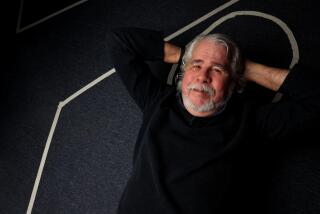Good Thing Heâs a Great Ice-Breaker : Shelton g. Stanfill is the out-of-towner whoâs moving in soon as the next president of the Music Center. Now, he talks about the job ahead and, yes, explains the role of the little âgâ
VIENNA, Va. â So whatâs with the little g ?
Thatâs the first thing people usually ask about when they approach Shelton g. Stanfill, the next president of the Los Angeles Music Center.
Stanfill, a pleasantly professorial sort who is about to leave his post as president and chief executive officer of the Wolf Trap Foundation for the Performing Arts, is more than happy to answer queries about his name. In fact, thatâs why heâs maintained the small g since he was about 20 years old.
âItâs been something of an icebreaker for a lot of people,â he explained during a recent conversation, just one day after returning from a three-week vacation in France, birthplace of his wife, Brigitte. âI get to talk to a lot of people I wouldnât get to talk to otherwise. It makes them comfortable, to ask that question.â
Maybe capitalizing on the small g will help break the ice for Stanfill, 53, when he arrives in Los Angeles in January to take over a very big task: raising funds for the Music Center of Los Angeles County--the downtown arts complex that houses the Los Angeles Philharmonic, the Los Angeles Music Center Opera, the Mark Taper Forum/Center Theatre Group and the Master Chorale.
Stanfill, who has headed Wolf Trap since 1988, previously served as executive director of the Hopkins Center at Dartmouth College, where he was responsible for the management and development of the performing arts, as director of cultural programs at Colorado State University and director of the National Arts Festival for the Winter Olympics in 1972.
In the middle of a recession, he will assume the $190,000-a-year post as president of the Music Center, Southern Californiaâs premier arts center and longtime symbol not only of artistic, but also social prestige. At the same time, the Music Center, the fund-raising arm for the centerâs resident performing arts companies as well as for its substantial educational program, faces more ambitious goals than usual: Its board plans to raise part of the funds for the new $200-million Walt Disney Concert Hall--a new home for the Philharmonic slated to open its doors in 1997--and the planned $17.1-million reconfiguration of the centerâs Ahmanson Theatre.
In addition, the Music Center has been rocked for two years by controversies over accounting and spending practices that ultimately led to the resignation of center president Esther Wachtell, as well an overhaul of the centerâs financial system.
*
So, the answer to the g question: When Stanfill was 18, between high school and college, he took a couple of years to bum around in Alaska, working odd jobs and trying to become a novelist, inspired by reading Ernest Hemingway and Thomas Wolfe.
He wrote, worked as a forest-fire fighter and a railroad gandy dancer, as well as doing time working at the local YMCA in exchange for food. â(Choosing Alaska) says how young and stupid I was; it was the most expensive place I could have gone to to bum,â he said.
The g was an adolescent affectation that Stanfill thought would lend him some literary distinction. But âI discovered I was not a writer,â Stanfill said cheerfully. âIt was a great discovery. It saved me a lot of grief. But it was an interesting time.â While he abandoned Alaska and his writing aspirations--entering Colorado State University in 1960 to major in medieval history--Stanfill kept breaking ice with the g .
The answers to other questions Stanfill may be asked in socially turbulent and financially troubled Los Angeles may not come so easily as the story of the g .
But Stanfill insists he is up to the job.
Stanfill will be leaving the woodsy serenity of Wolf Trap, the nationâs only national park dedicated to the performing arts. Fifteen miles west of Washington, D.C., Wolf Trap is built on 100 acres of farmland donated to the U.S. government by Catherine Filene Shouse, now 97, who remains an active participant in Wolf Trap affairs. Shouse also donated the funds to build the 6,800-seat outdoor theater, the Filene Center. Wolf Trap is operated in a partnership between the nonprofit Wolf Trap Foundation and the National Park Service.
Shouseâs role in establishing Wolf Trap parallels that of Dorothy Buffum Chandler, 92, wife of then-Los Angeles Times publisher Norman Chandler, who founded the nonprofit Music Center on county-owned land in 1964, although Chandler is no longer involved in the day-to-day workings of the Music Center.
The Wolf Trap Foundation also operates the Barns of Wolf Trap, a gift from Shouse, which are open year-round. Impressed by the acoustical quality of the wooden barn after attending a concert in a barn in Maine, Shouse had two hand-hewn 18th-Century barns in upstate New York dismantled and brought to Wolf Trap. When they were put back together, the barns were turned inside out so the weathered beams of the barns are now on the inside.
In 1982, the Filene Center burned to the ground. At a cost of $18 million (half from the government, half from donated funds), it was rebuilt--out of wood. But now, a tour guide is quick to point out, the center features an elaborate $1.7-million fire detection and protection system.
With its wooden buildings blending naturally into a backdrop of warm fall leaves and a cool gray mist, with nearby cider mills crushing apples and offering Halloween pumpkins for sale, Wolf Trap looks like a home for wayward deer, not for controversy or financial strife.
But, Stanfill said, appearances can be deceiving. âAt Wolf Trap, there had been a whole series of years of unbalanced budgets and fund-raising problems--right after I got here they were about to default on an $18-million loan from the government (for costs incurred by the Filene center fire) and they were three-quarters of a million dollars off their budget.â
The budget was balanced during Stanfillâs tenure.
*
In the past 10 years or so, Wolf Trap also experienced growing pains and management upheavals, which resulted in a revolving door of leadership, with its presidents lasting an average of 11 months apiece. Neatly sidestepping questions about Shouse, whom some Wolf Trap sources have described as difficult to deal with, Stanfill described the problems as the inevitable result of an arts center moving from âa founder-basedâ organization to a âboard (of directors)-based one.â
âThat very often creates tensions and conflicts,â Stanfill said. âBut they are there in any organization. It is a critical point for any organization, whether it is a business organization, or a nonprofit. Itâs necessary in terms of securing an institution for the future. Founders do not live forever.â
Added Stanfill: âMrs. Shouse is an extraordinary woman. If she had been born a lot later, Iâm sure she would have been Secretary of State.â Shouse was unavailable for comment.
As for the recession, and the challenges of multiculturalism and diversity that have faced the Los Angeles arts community, Stanfill said heâs already in the middle of that discussion.
âWashington has many problems, and believe me, Northern Virginia is as much part and parcel Washington, D.C., as Pasadena is of L.A.,â Stanfill said. âAnd it has a lot of its own significant problems. The same sort of problems exist here. There is a little more greenery left, there are deer on our property. So on one level, that gives the impression that itâs bucolic, but that is not truly representative.
âIn this county, Fairfax County, the school districts deal with 100 different languages and dialects. That is not too different from descriptions Iâve seen of Los Angeles County.
âThe other thing you donât get a sense of when you are driving through this countryside is that Fairfax County, in terms of square footage of office space, is No. 5 in the country. Itâs not in high-rises, itâs spread throughout, but there is an enormous business community here.â
Stanfill also notes that he is no stranger to cold economic realities. âSouthern California is finally being hit with the recession, but I have been following it around the country,â he said. âThe energy boom went bust about 1980--Colorado and Denver were supposed to become the energy capitals of the country. And when I was in New England (at Dartmouth), the Massachusetts Miracle fell apart a year and a half before I left there, and it hit here about a year and a half before I arrived.
âFor years, they said Washington was recession-proof. Always reach for your wallet when somebody says that.â
*
C. Joseph LaBonte, chairman of the board of the Philharmonic, said Stanfillâs fund-raising challenge in Los Angeles will be âpretty formidable, with regard to a soft economy, and with regard to the unfortunate publicity the Music Center has gotten in the last couple of years. But--and itâs a big but--I do think he is up to it.
âI am really quite optimistic,â La Bonte continued. âWe know we are in a trough, but we feel comfortable that we have bottomed out, and there is nowhere to go but up.â
Stanfill said the Music Center, which selected him after an extensive nationwide search, was frank with him about the centerâs recent financial and management problems, giving him access to recent budget reports that reflected fund-raising difficulties (the Music Center missed its 1992-93 fund-raising goal of $14.5 million by $1.6 million) as well as press clippings detailing the centerâs recent financial embarrassment.
*
Difficulties for the Music Center began in 1991, when Music Center officials erroneously announced they had reached their $17.5-million fund-raising goal. They later disclosed that the center had fallen $1.3 million short of the goal, which prompted staff changes and accounting reforms.
In July, 1992, the former vice president in charge of finances, James B. Black, who had been placed on unpaid leave, said he was paid $150,000 in salary and benefits after he alleged that he was made a scapegoat for the centerâs financial problems. Black said both he and then-president Wachtell were equally responsible for the problems.
These months revived the bitter infighting that has dogged the center for years and had split its major donors into two bitter camps: those who supported Wachtell, and those who did not.
In December, 1992, Wachtell announced that she would step down from the $200,000-a-year post July 15, 1993; she reached a $200,000-resignation agreement with the center. During the months in between her announcement and her departure, controversy over her presence continued. According to center records and interviews, she repeatedly asked the nonprofit arts center to reimburse her for political contributions, an action that could have jeopardized the centerâs tax-exempt status. Wachtell denied the allegation and said she never was reimbursed.
The Music Center initiated an exhaustive search of its records for evidence of reimbursement after inquiries by reporters. Although there was no evidence of direct reimbursement, the inquiry was inconclusive, according to board members.
Since Wachtellâs departure, Music Center board chairman Robert B. Egelston, 62, of Pasadena, former chairman of the Capital Group money management firm, has served as acting president of the center on a volunteer basis.
Stanfill remains unfazed by the centerâs past and says letters from those involved with the Music Center express an eagerness for new leadership. And, although he regrets leaving Wolf Trap during a period of growth and change--and is apprehensive about the idea of living in a city where he will be forced to commute to work--Stanfill is looking forward to the challenge. He is particularly excited about the Music Centerâs education program, which he said is regarded as one of the strongest such programs in the country.
He would like to see the Music Center play an increased role in the Los Angeles Festival, the tri-annual festival of arts and culture directed by Peter Sellars that has become a symbol of the cityâs push for multiculturalism in the arts. âI think there are things that are not happening at the Music Center in a full way which I think should be, for which people want to find a resource,â he said.
*
While Stanfill played a substantial role in programming the stages of Wolf Trap, his new position will be limited to fund-raising. Heâs OK with that: âThe fact is, the Music Center already is rich in programmers,â he said.
He is also not afraid of looking for donors on new turf; he said working in the arts in Colorado gave him some familiarity with Southern Californiaâs major financial players. âWhen you really look at it, itâs still a wealthy community,â he said. âYou certainly have enormous financial and structural problems . . . (but) there are certainly enormous resources there, not just in terms of money, but in human energy.
âYou use, in the best sense of that word, the members of your board, who do come out of that community. You use your acquaintances in the (arts) field to be introduced to the field. And you try desperately to get to places where people donât expect you to be, and where you donât know what you will find. Itâs a sort of serendipity--either you tap new resources, or at least you better understand the complexities of the community.â
Stanfill is also looking forward to returning to the West--which in the arts, he said, âhas a different sort of energy, a different kind of outlook than East Coast companies or artists. When I was at Dartmouth, it was interesting to me just how isolated and parochial the East Coast is about the West.â
âL.A. is really the 21st-Century American city, based on the automobile,â he added. âIt is the seminal test for the future. And that fascinates me. The sort of thing that Peter Sellars is interested in fascinates me.â
Stanfill said his interest in the arts began when he was a child growing up in the small mountain town of Craig, Colo., where his father, Stanfill Day Stanfill, managed a movie theater (Stanfill does not know why his father was named Stanfill Stanfill, but describes him as âdefinitely eccentric.â Stanfill also has a brother named Stanfill Blaine Stanfill).
As a child, Stanfillâs two favorite movies were 1944âs âHenry Vâ with Laurence Olivier, and âThe Snake Pitâ (1948), starring Olivia de Havilland as a wife and mother struggling back to mental health, locked in a state facility. âThey probably wondered why an 8-year-old asked to see âThe Snake Pitâ three times,â he said, laughing.
Though Stanfill majored in medieval history at Colorado State University, he involved himself deeply in the arts: He helped found a student radio station (he was its first classical program director) that later became a National Public Radio station, and launched a film series, as well as a literary newspaper.
*
When he decided he lacked the dedication to pursue a Ph.D. in medieval history, he taught history and literature in the public schools in Colorado for several years, but eventually returned to the arts, assuming the position of director of cultural programs at Colorado State University.
Stanfill has three children: Son Shaun, 30, has a degree in music composition and works in the computer industry; daughter Jacqueline, 24, is studying science writing in a masterâs program at New York University, and Natasha, 22, is a recently graduated art history major, seeking a museum position.
âThe point is whether or not, as an institution, you are doing something that has a substantive result in peopleâs lives,â Stanfill mused. âThat is essentially, and hopefully, what the arts are all about. There is a moment of truth--Bertolt Brecht talks about it--when everything comes together and you know something you never knew before. Thatâs the reason the arts are worth fighting for.â*
More to Read
The biggest entertainment stories
Get our big stories about Hollywood, film, television, music, arts, culture and more right in your inbox as soon as they publish.
You may occasionally receive promotional content from the Los Angeles Times.










